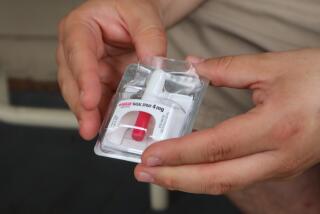As opioid death toll worsens, California doctors will soon be required to perform database checks
- Share via
By the time the 59-year-old woman overdosed in the late summer of 2013, she’d been given 75 prescriptions by three primary care doctors, a psychiatrist and a pain specialist in one year.
Her deadly cocktail: an opioid painkiller, a sleeping aid and anti-anxiety medication.
Had any of the five physicians treating her been aware she’d been “shopping” around for prescriptions? Had they warned her of the dangerous combinations? Had anyone tried to intervene?
For decades, California has kept a prescription history database for doctors and pharmacies to consult, but many healthcare providers have ignored it — and the potential life-saving clues it provides.
Beginning Oct. 2, a new law makes consulting that database mandatory.
By logging into a web-based program, prescribing physicians should be able to easily spot signs of a “doctor shopper” — someone who sees multiple doctors to load up on prescription drugs — or indications of dangerous medication combinations. Armed with that information, physicians can provide drug safety warnings, deny the patient’s request for prescriptions, and even offer help when drug abuse is suspected.
“California created the first system to track prescriptions of the strongest painkillers, but our state fell behind as the opioid crisis grew,” said state Sen. Ricardo Lara (D-Bell Gardens), who drafted the legislation in 2015. “I wrote SB 482 to require that doctors and others consult the CURES system before prescribing these powerful and addictive drugs. This tool will help limit doctor shopping, break the cycle of addiction and prevent prescriptions from ever again fueling an epidemic that claims thousands of lives.”
The Controlled Substance Utilization Review and Evaluation System, or CURES, provides an accounting of a patient’s prescriptions, the doctors who prescribed them and the pharmacies that filled them.
It allows the orthopedist to see what the psychiatrist is doing and the emergency room doctor to see what the primary care physician is doing.
“I think people make the mistake of thinking it’s just for doctor shopping,” said Dr. Roneet Lev, chief of emergency medicine at Scripps Mercy Hospital who has been an early advocate of CURES. “Using CURES just makes you a smarter, better doctor.”
The law generally requires all healthcare practitioners to consult the database before issuing new prescriptions to patients, or once every four months if a prescription remains a part of the patient’s treatment plan.
There are exceptions. Emergency departments and surgical teams can prescribe a nonrefillable five-day supply without first consulting.
In other emergency situations when checking CURES is not reasonably possible, a five-day nonrefillable supply is also allowed, but the prescriber must document the reason for skipping consultation.
The law does not apply to hospice care.
The law covers prescriptions for Schedule II to Schedule IV drugs — from oxycodone, morphine and fentanyl to anti-anxiety meds such as alprazolam and clonazepam.
Some physicians, however, still wonder whether CURES is ready for prime time. The platform has been fraught with technical problems over its history, and its current format makes some doctors anxious about the extra, time-consuming steps that will be added to their daily practices.
“I think it’s going to be one of those things that a year from now is going to be secondhand to them,” said Kimberly Kirchmeyer, executive director of the Medical Board of California. “It’s just the first round of it gets hard for them. Any additional administrative task for physicians in the world they live in is difficult for them, and we completely understand that.”
The licensing board, which will help oversee compliance, has been offering training for prescribers around the state to gear up for the requirement and calm concerns.
“I think every doctor in California will gladly do it as long as there’s a pot of gold at the end of the rainbow,” said Dr. Jason Toranto, chief of plastic surgery at Senta Clinic. “As long as the patient is going to do better, that’s what it’s all about.”
CURES debuted in 1997, more as an investigative tool for the state Department of Justice. Its first rollout was clunky and far from user-friendly.
It was revamped in 2009, but a Los Angeles Times investigation in 2012 found less than 10% of eligible healthcare providers and pharmacists had even signed up for access to the database.
At the same time — while an opioid crisis was beginning to take hold — a $70-million budget cut to the Justice Department threatened to dismantle CURES.
Funding was found in 2013 legislation that levied a $6 annual fee on prescribers and pharmacists. The law also required all eligible healthcare professionals to sign up for a CURES account by mid-2016.
Still, there has been some resistance to requiring consultations with CURES, mostly on arguments that the program just wasn’t stable.
A law that would have made its use mandatory failed at the ballot box in 2014, although the measure was included as part of a proposal that would have expanded limits on medical malpractice awards and called for drug testing of physicians.
In 2016, CURES 2.0 was unveiled as a much-improved interface.
Even then, some providers complained that CURES 2.0 wouldn’t work with their computer systems and software, namely older versions of Internet Explorer.
Lara’s law passed in 2016, but CURES wasn’t ready. The Justice Department still had to certify it could withstand the pressure, a review that was completed April 2. The law goes into effect six months from that date.
“After working with the state for years to ensure adequate educational and technical support for physicians who will have to rely on CURES as part of their prescribing workflow, the California Medical Assn. is optimistic that CURES is ready for statewide use,” said the group’s president, Dr. Theodore M. Mazer. “CMA will continue to monitor the implementation of CURES and work with stakeholders to ensure it has adequate support.”
CURES could still use some improvements, namely the ability to push a patient’s prescription history directly to the provider as part of a patient’s file rather than require doctors to log in to a separate website. That ability is coming, mostly for doctors with access to large IT networks in big healthcare systems and hospitals. It may be more difficult for smaller private practices to implement.
There are also all the other headaches that come with depending on technology.
“It is not perfect,” said Lev, who was the first doctor to sign up for a CURES 2.0 account. “I was on the computer the other day and had to put in a new (CURES) password and the computer wouldn’t let me. All day I couldn’t use it. I felt naked without it.”
The nature of Lev’s practice as an ER physician means she would be exempt most of the time from having to check CURES under the new law. A nonrefillable, 12-pill prescription to treat health problems in the short term is common in her book.
“I don’t need to check it,” she said, “but I do.”
Lev has unique insight into the dangers of prescribing. A few years ago she launched a project called “Death Diaries,” which looked at accidental prescription drug deaths in San Diego County and the clues the victims’ prescription histories might shed.
She found that 80% of people died with a combination of substances in their systems. Combinations of opioids and benzodiazepines were common. Nearly 70% of overdose victims were chronic users, and 20% were doctor shoppers. It all led her to conclude that many doctors were not checking CURES.
The 59-year-old overdose victim in 2013 was among the cases she analyzed as part of the project.
The new law tries to address the role of prescribers as the deadly opioid epidemic plays out across the country.
According to research cited by the National Institute on Drug Abuse, 21% to 29% of patients prescribed opioids for chronic pain misuse them, and 8% to 12% develop an opioid use disorder. Also, about 80% of people who use heroin — which is cheap and readily available — first misused prescription opioids, the institute says.
Opioid prescribing behaviors have shifted in response to the crisis. From 2013 to 2017, the number of opioid prescriptions decreased by 22%, or more than 55 million, in the U.S., according to a 2018 report by the American Medical Assn.
State drug databases have also become more popular. In 2017, healthcare providers accessed such databases more than 300 million times, a 148% increase from the previous year, according to the AMA.
California will be among a several states — including New York, Kentucky and Tennessee — that require prescription drug database consultation.
Research has shown such mandates appear to have helped reduce prescription overdose deaths. For instance, a 2017 study of New York’s program, called I-STOP, showed that prescription opioid deaths leveled off after the mandatory use requirement in 2013, but heroin overdose death rates continued to rise, mirroring a national trend.
It’s unknown when the crisis will reverse. In 2017, more than 72,000 people in the U.S. died from accidental drug overdoses, up from more than 63,000 the previous year, according to the Centers for Disease Control and Prevention. That includes prescription and illicit drugs.
Last year, nearly 68% of drug deaths were attributed to opioids.
Lev said it is important for doctors to focus on what they can do.
“A lot of statistics mix illicit with prescription drugs, which makes it very confusing to the medical community,” she said. “I always say, ‘These are your prescriptions. Just do what you can do with that, and let law enforcement do what they can.’”
Davis writes for the San Diego Union-Tribune.
More to Read
Sign up for Essential California
The most important California stories and recommendations in your inbox every morning.
You may occasionally receive promotional content from the Los Angeles Times.










